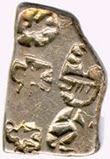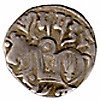.
Ancient India Coinage
Punch Marked Coins
The Indus valley civilisation of Mohenjo-Daro and Harappa dates back between 2500 BC and 1750 BC. There, however, is no consensus on whether the seals excavated from the sites were in fact coins.

Seals of Mohenjo-Daro
The first documented coinage is deemed to start with 'Punch Marked' coins issued between the 7th-6th century BC and 1st century AD. These coins are called 'punch-marked' coins because of their manufacturing technique. Mostly made of silver, these bear symbols, each of which was punched on the coin with a separate punch.
Dynastic Coins
Kushan
Satavahana
The Satavahanas were the early rulers of the region between the rivers, Godavari and the Krishna. They were also referred to as the Andhras. They soon brought under their control, both the Western-Deccan and Central India. The dates of their coming in to power are contentious and are variously put between 270 BC to 30 BC. Their coins were predominantly of copper and lead, however, silver issues are also known. These coins carried the motifs of fauna like elephants, lions, bulls, horses, etc. often juxtaposed against motifs from nature like hills, tree, etc. The silver coins of the Satavahanas carried portraits and bilingual legends, which were inspired by the Kshatrapa types.
Western Kshatrapa
The term Western Kshatraps alludes to the set of rulers who ruled Western India between the 1st and 4th Century AD. The legends on the coins were generally in Greek and Brahmi. Kharoshti too was used. The Western Kshatrap coins are reckoned to be the earliest coins bearing dates. The common copper coins are the 'bull and hill' and the 'elephant and hill' types.
Coin of the Yaudheyas
Gupta
Gupta coinage (4th-6th centuries AD) followed the tradition of the Kushans, depicting the king on the obverse and a deity on the reverse; the deities were Indian and the legends were in Brahmi. The earliest Gupta coins are attributed to Samudragupta, Chandragupta II and Kumaragupta and their coins often commemorate dynastic succession as well as significant socio-political events, like marriage alliances, the horse sacrifice, etc (King and queen type of coin of Chandragupta 1, Asvamedha type, etc.), or for that matter artistic and personal accomplishments of royal members (Lyrist, Archer, Lion-slayer etc.).
12th - 14th Centuries
Ancient India Coinage
Punch Marked Coins
The Indus valley civilisation of Mohenjo-Daro and Harappa dates back between 2500 BC and 1750 BC. There, however, is no consensus on whether the seals excavated from the sites were in fact coins.

Seals of Mohenjo-Daro
The first documented coinage is deemed to start with 'Punch Marked' coins issued between the 7th-6th century BC and 1st century AD. These coins are called 'punch-marked' coins because of their manufacturing technique. Mostly made of silver, these bear symbols, each of which was punched on the coin with a separate punch.
Punch Marked Coin, Silver Bentbar
Issued initially by merchant Guilds and later by States, the coins represented a trade currency belonging to a period of intensive trade activity and urban development. They are broadly classified into two periods : the first period (attributed to the Janapadas or small local states) and the second period (attributed to the Imperial Mauryan period). The motifs found on these coins were mostly drawn from nature like the sun, various animal motifs, trees, hills etc. and some were geometrical symbols.
Description | Obverse | Reverse
Seven Symbols
Five Symbols
Five Symbols
Silver Punchmarked Coins
Representative Symbols appearing on Punch Marked Coins
Mauryan Art Form
Dynastic Coins
Dating of regular dynastic coin issues is controversial. The earliest of these coins relate to those of the Indo-Greeks, the Saka-Pahlavas and the Kushans. These coins are generally placed between the 2nd century BC and 2nd century AD. Hellenistic traditions characterise the silver coins of the Indo-Greeks, with Greek gods and goddesses figuring prominently, apart from the portraits of the issuers. These coins with their Greek legends are historically significant, as the history of the Indo-Greeks has been reconstructed almost entirely on their evidence. The Saka coinage of the Western Kshatrapas are perhaps the earliest dated coins, the dates being given in the Saka era which commences in AD 78. The Saka era represents the official calendar of the Indian Republic.
Indo-Greek Coins
Kushan
Earliest Kushan coinage is generally attributed to Vima Kadphises. The Kushan coins generally depicted iconographic forms drawn from Greek, Mesopotamian, Zorastrian and Indian mythology. Siva, Buddha and Kartikeya were the major Indian deities portrayed. Kushan gold coins influenced subsequent issues, notably those of the Guptas.
Coins of the Kushans
Kushan Art Form, Statue of Kanishka, Mathura Museum
Satavahana
The Satavahanas were the early rulers of the region between the rivers, Godavari and the Krishna. They were also referred to as the Andhras. They soon brought under their control, both the Western-Deccan and Central India. The dates of their coming in to power are contentious and are variously put between 270 BC to 30 BC. Their coins were predominantly of copper and lead, however, silver issues are also known. These coins carried the motifs of fauna like elephants, lions, bulls, horses, etc. often juxtaposed against motifs from nature like hills, tree, etc. The silver coins of the Satavahanas carried portraits and bilingual legends, which were inspired by the Kshatrapa types.
Coins of the Satavahana
Western Kshatrapa
The term Western Kshatraps alludes to the set of rulers who ruled Western India between the 1st and 4th Century AD. The legends on the coins were generally in Greek and Brahmi. Kharoshti too was used. The Western Kshatrap coins are reckoned to be the earliest coins bearing dates. The common copper coins are the 'bull and hill' and the 'elephant and hill' types.
Description | Obverse | Reverse
Rudrasimha I, 180-196 AD
Viradaman, 234-238 AD
Coins of the Western Kshatrapas
Other Coins
In the interregnum between the fall of the Maurayans and the rise of the Guptas various tribal republics in the Punjab and monarchies in the Indo-Gangetic plain issued coins. Most coins were issued in Copper. The coins of the Yaudheyas were influenced in design and motif by the coins of the Kushans. They followed the weights of the Indo-bacterian rulers.
Coin of the Yaudheyas
Gupta
Gupta coinage (4th-6th centuries AD) followed the tradition of the Kushans, depicting the king on the obverse and a deity on the reverse; the deities were Indian and the legends were in Brahmi. The earliest Gupta coins are attributed to Samudragupta, Chandragupta II and Kumaragupta and their coins often commemorate dynastic succession as well as significant socio-political events, like marriage alliances, the horse sacrifice, etc (King and queen type of coin of Chandragupta 1, Asvamedha type, etc.), or for that matter artistic and personal accomplishments of royal members (Lyrist, Archer, Lion-slayer etc.).
Description | Obverse | Reverse
King as Horseman
King as Lion Slayer
King & Queen Type
Fan-Tailed Peacock
Coins of the Guptas
Post-Gupta Coinage
Post-Gupta coinage (6th-12th centuries AD), is represented by a monotonous and aesthetically less interesting series of dynastic issues including those of Harsha (7th century AD, Kalachuri of Tripuri (11th century AD) and early medieval Rajputs (9th-12th centuries AD). Gold coins struck between this period are rare. These were revived by Gangeyadeva the Kalachuri ruler who issued the 'Seated Lakshmi Coins' which were copied by later rulers both in gold as well as in debase form. The Bull & Horseman type of coins were the most common motif appearing on coins struck by the Rajput clans. In western India, imported coins like the Byzantine solidi were often used reflecting trade with the Eastern Roman Empire.
Post-Gupta Coinage
Post-Gupta coinage (6th-12th centuries AD), is represented by a monotonous and aesthetically less interesting series of dynastic issues including those of Harsha (7th century AD, Kalachuri of Tripuri (11th century AD) and early medieval Rajputs (9th-12th centuries AD). Gold coins struck between this period are rare. These were revived by Gangeyadeva the Kalachuri ruler who issued the 'Seated Lakshmi Coins' which were copied by later rulers both in gold as well as in debase form. The Bull & Horseman type of coins were the most common motif appearing on coins struck by the Rajput clans. In western India, imported coins like the Byzantine solidi were often used reflecting trade with the Eastern Roman Empire.
Description | Obverse | Reverse
Seated Lakshmi
Bull & Horseman
South Indian Coinage
The symbols and motifs on South Indian coin issues were confined to dynastic crests such as the boar (Chalukya), bull (Pallava), tiger (Chola), fish (Pandya and Alupas), bow and arrow (Cheras) and lion (Hoysala) etc. The Yadavas of Devagiri issued 'Padmatankas' with an eight-petalled lotus on the obverse and a blank reverse. Coin legends refer to names or titles of the issuer in local scripts and languages. Decorative features are rare and divinities are almost absent till the medieval Vijayanagar period (14th - 16th centuries AD).
Description | Obverse | Reverse
Coins of the Cheras
11th - 13th Centuries
Coins of the Cheras
11th - 13th Centuries
Coins of the Cholas
9th - 13th Centuries
Coins of the Alupas of Udipi
11th - 13th Centuries
Padmatankas,
Coins of the Yadavas of Devagiri12th - 14th Centuries
Foreign Coin Hoards found in India
Ancient India had considerable trade links with the Middle East, Europe (Greece and Rome) as well as China. This trade was carried out over land partly along what came to be alluded to as the silk route and partly through maritime trade. By the time of Pliny, the Roman historian, Roman trade with India was thriving, and indeed creating a balance of payments problem for the Roman Empire. In South India, which had a thriving maritime trade, Roman coins even circulated in their original form, albeit slashed at times as a gesture disclaiming intrusions of foreign sovereignty.
A slashed Roman Aureus of Augustus
Description | Obverse | Reverse
Roman Find in South India
Byzantine Find in South India
























































No comments:
Post a Comment